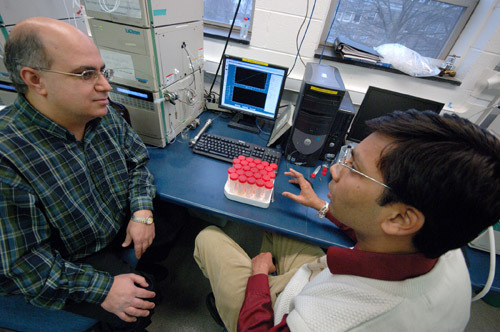
University of Rhode Island professor Keykavous Parang is hoping he is close to succeeding where other researchers have so far failed in the fight against HIV and AIDS.
Parang, an associate professor of biomedical and pharmaceutical sciences, and a team of researchers are preparing for the clinical testing of a topical cream that could prevent the transmission of HIV, the virus that can lead to AIDS.
The cream, which Parang has been working on for four years, is intended for women to apply before sexual intercourse and could also prove effective against other types of sexually transmitted diseases, such as syphilis.
“There’s an urgent need to develop an over-the-counter drug for the prevention of HIV, especially for females,” Parang said. “The major advantage of this microbicide is that it will be under the control of the women. They can protect themselves.”
Several compounds are undergoing pre-clinical trials on rabbits, and if everything goes well, trials involving humans could be a year away, Parang said.
Parang and his URI collaborators, Hitesh Agarwal and Anil Kumar, focused on the topical cream to deliver the compound because trials are less stringent than with pills and injections, where much more medication gets into the body.
It’s hoped that an inexpensive non-prescription version of the cream – which might also contain a spermicide – could be available in five years or so. “You never know,” he added. “That might a very optimistic view.”
And there’s a possibility that the compounds under development – if put in tablet or injection form – could be used for treating people already infected with HIV. But testing for that use would take much longer.
“Our data indicate that the compounds are much more potent than the current available drugs,” Parang said. “But we don’t want to go there yet. That’s a long process.”
At the same time, Parang is working on other illness-fighting fronts. The professor is developing a compound effective against Src, a cell protein linked to the development of breast, colon, lung, ovarian, gastric and pancreatic cancers.
Parang’s work on the anti-HIV and cancer-fighting compounds has garnered lots of financial backing. So far, Parang has received $1.2 million in research grants in the last year for both efforts.
Working in collaboration with Gustavo Doncel at the Eastern Virginia Medical School’s Clinical Research Center, URI researchers have been awarded $563,000 since 2003 from the Contraceptive Research and Development Program to advance the topical cream.
If the cream proves successful, the intellectual property can be valuable to URI, and the inventors typically receive royalties. Parang said pharmaceutical companies haven’t yet shown an interest. That may be partly because researchers also haven’t sought publicity.
More importantly, an effective HIV preventative could slow the spread of HIV, which has infected many millions worldwide. Some estimates say as many has 25 million have died of AIDS since it was first recognized in the early 1980s.
Ever since, researchers have worked to develop a way to prevent transmission of HIV.
Condoms are an effective prevention method, but they’re not always available or used properly. Vaccines have proved unreliable, too. In fact, Parang said a promising vaccine Merck & Co. was testing failed in trials a few months ago.
Then there are microbicides like Parang’s cream.
Developing a microbicide to deal with HIV is competitive, with researchers worldwide working on various compounds. Indeed, Pfizer Inc. said last month that it would license a new HIV drug to a nonprofit agency that would try to convert it into a vaginal gel or film to prevent HIV transmission.
“Our goal is to be helpful to others in preventing this disease,” Parang said. “A lot of people are dying because of it.” •










